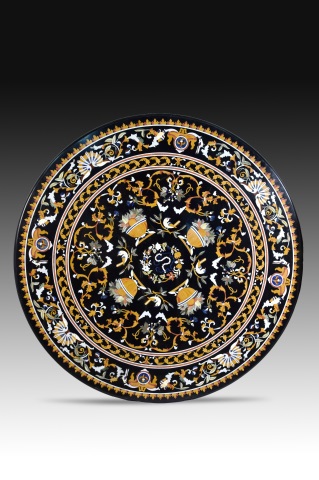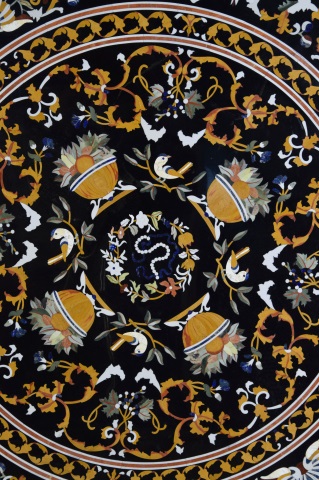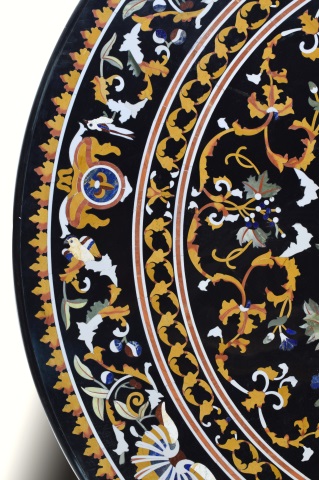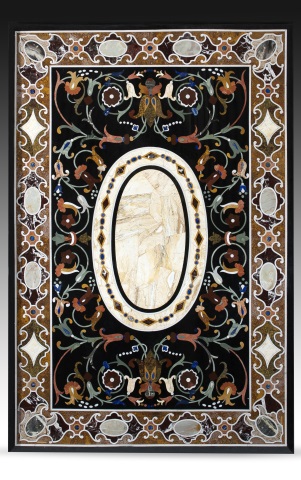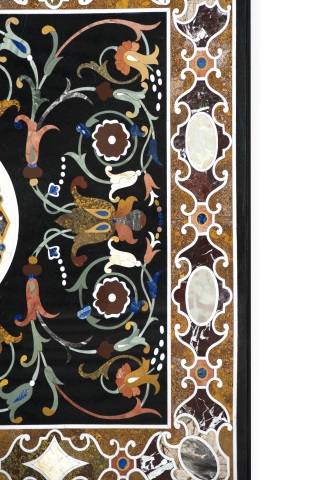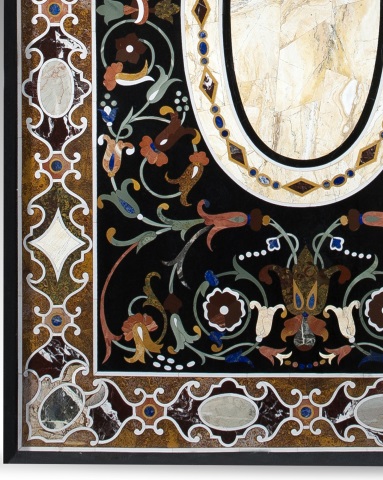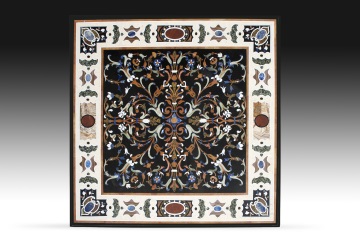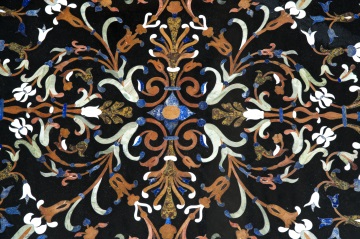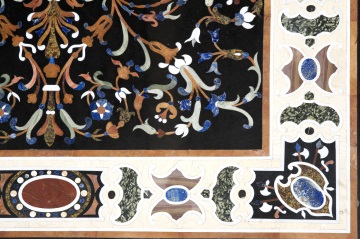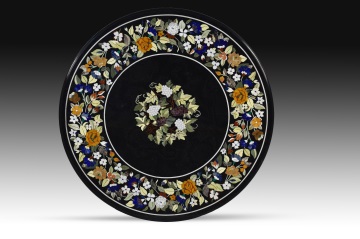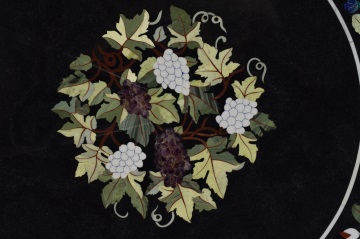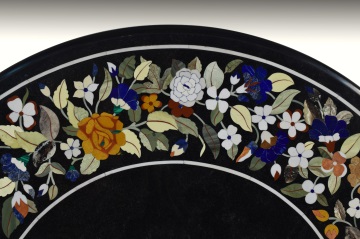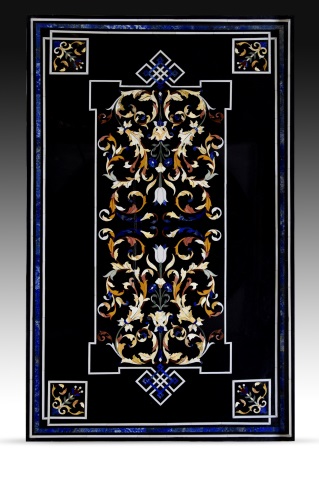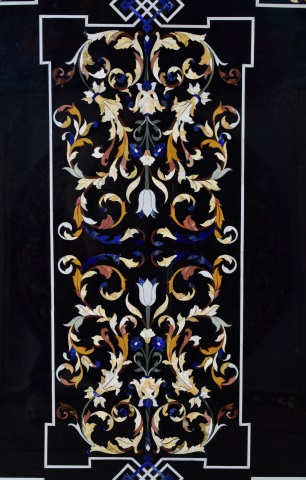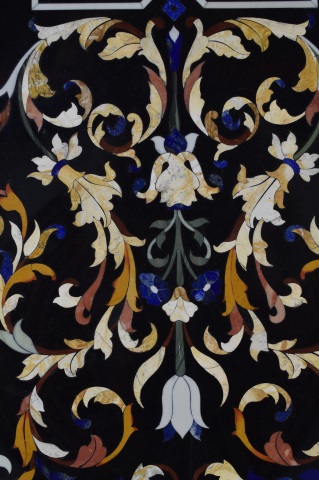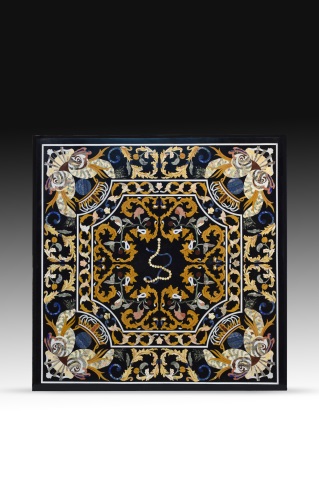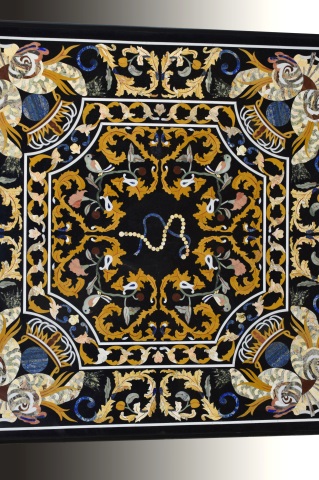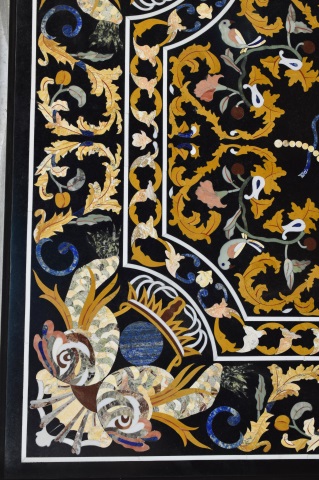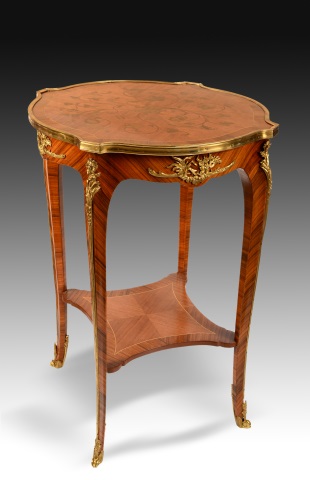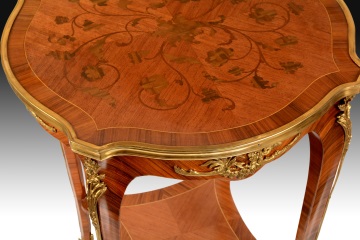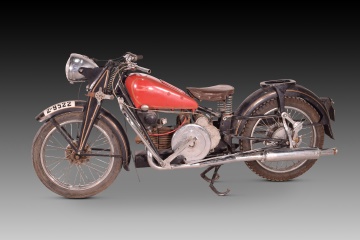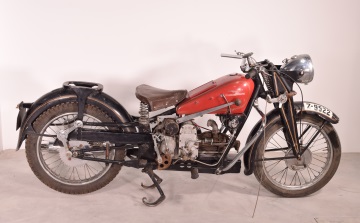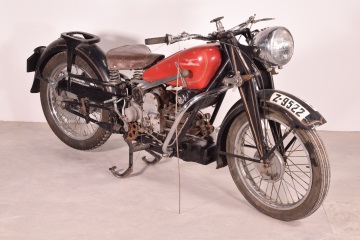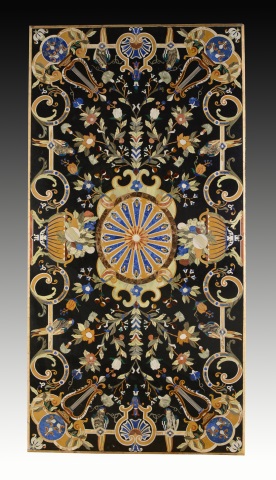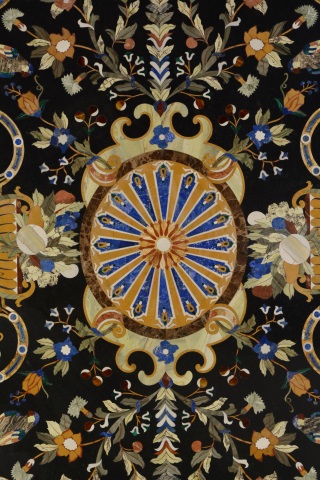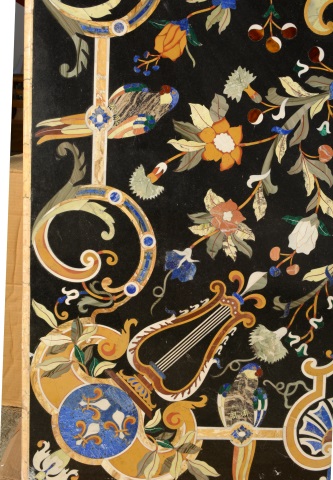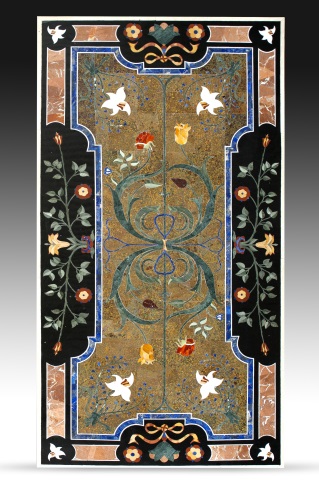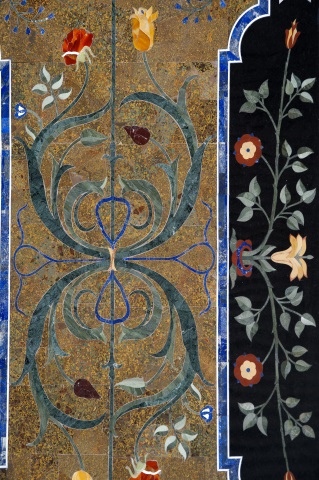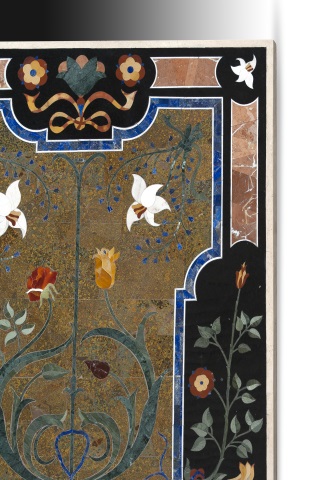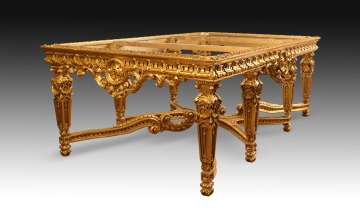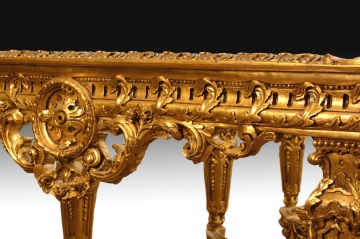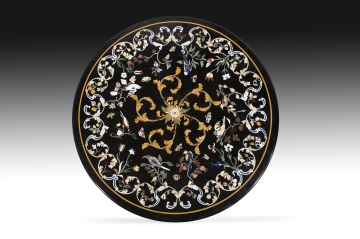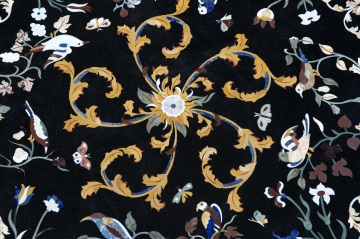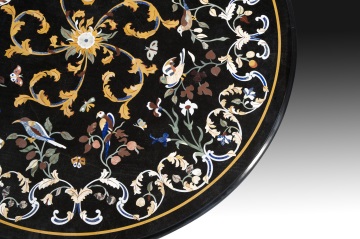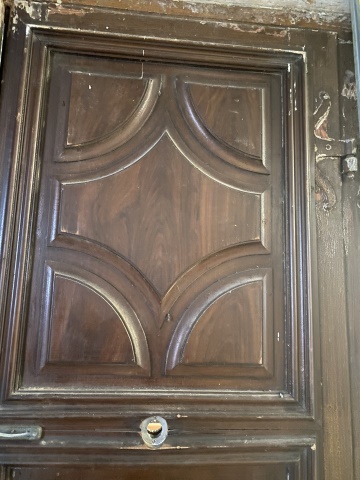
-
CIRCULAR PIETRA DURA TABLETOP. MARBLE AND HARDSTONES.
Circular table top in marble and hard stone. Inspired by Italian models from the 16th-17th centuries. In the centre of the panel, surrounded by a garland of flowers, there is a pearl necklace with a bow. Around this element, there are four vases with birds perched on branches interspersed and, further outwards, a band with vegetal scrolls. This area is framed by another with simplified scrolls and another with more elaborate ones interspersed with scallop shapes and heraldic shields, and perched birds. The fleur-de-lis on the border clearly shows the influence of Gobelins' work on this panel. The French workshop was set up to make this type of inlay for the French court, and is the heir to the native centre of “hard stonework”: the Florence of Piero de Medici and Lorenzo the Magnificent, who wanted to revive a Roman technique called “opus sectile” mosaic. Mention should also be made of the Royal Workshop of Naples and the one created by Charles III at the Royal Site of El Buen Retiro in Madrid, which closed at the beginning of the 19th century. After 1600, the primacy of the decoration that appeared in the 15th century is clear, and elements such as birds, butterflies and pearl necklaces were added over time. The present example inherits this whole tradition: compare the table made by Francesco Ghinghi in the Real Laboratorio Delle Piedre Dure in Naples (catalogue number O00511) and the board (O00466) from around the mid-18th century, both in the Museo del Prado in Madrid, those kept in the Museo Opificio delle Pietre Dure in Florence (especially works such as the board made as a model for a table by Jacopo Ligozzi around 1610). Traditionally, a technique very similar to inlay was used, but instead of wood, using marbles of different colours and veins and hard stones (greater than 6 on the Mohs scale) such as lapis lazuli, agates, etc. In the present example, many of those used in works between the 16th and 18th centuries have been included, making it an outstanding work.DECORATION
· Size: Diam. 150 cms.
Ref.: AWD1211 ... -
PIETRA DURA TABLETOP. MARBLE AND HARDSTONES.
Rectangular table top with marble and hard stones. Inspired by Italian models from the 16th-17th centuries. The vein of a particular stone has been highlighted by placing it in the centre and surrounded by a necklace with round and rhomboidal beads. Around it, a decoration based on floral scrolls stands out, with a marked classical inspiration. To complete the composition, without taking away the central area's prominence, the outer band shows a series of empty mirrors within cartouches reminiscent of those used in the Renaissance. The technique is very similar to inlay, but uses marble and hard stones (more than 7 on the Mohs scale) to make these designs. Desks, boards and other objects were made with “hard stone work”. Lapis lazuli was usually used together with Belgian marble as a background, accompanied by jade, chalcedony, etc. The price of the material and the specialized labor raised the cost of this type of artwork so much that its recipients were only the main houses and courts of the time, which is why today they are only preserved in prominent private collections and important museums. Piero de Medici and Lorenzo the Magnificent began to support a series of works in Florence to revive, with thematic and technical changes, the Roman mosaic technique called “opus sectile”. It was during this period that the greatest decorative variety was produced, because, from around 1600, naturalistic motifs were the ones that ended up prevailing. Over the years, birds, parrots, lacework, pearls, etc. were also added. The work with hard stones was so successful that, from the 17th century, a series of workshops were created in Europe that continued with this tradition, among which the Gobelins Factory in France, the Royal Workshop of Naples and the El Buen Retiro factory in Madrid stand out. Compare this panel with other masterpieces: the “Panel of the Duke of Osuna” (O00501) made in 1614 and kept in the Museo del Prado in Madrid has a band on the outside that is reminiscent of this one; the “Farnese Table” in the Metropolitan Museum of New York (58-57 AD) also stands out for its grain in the central area; and some are kept in the Museo Opificio delle Pietre Dure in Florence.DECORATION
· Size: 180x120 cms.
Ref.: AWRT229 ... -
SQUARED PIETRA DURA TABLETOP. MARBLE AND HARDSTONES.
Square table top. Marble and hard stones. Inspired by Italian models from the 16th-17th centuries. A frame of simple geometric elements and white oval shields accompanied by architectural details highlights the decorative motif in the centre thanks to its light tones. This motif, set against a dark background, is made up of plant and flower scrolls organised in lines towards the interior, camouflaged by these stems, so that, despite the abundance of decoration, the four-petaled flower in the centre stands out. The “hard stone work” used in this table is very similar to marquetry, but uses marbles and stones with a hardness greater than 6 on the Mohs scale. The idea arose in Florence, when trying to revitalize a type of mosaic used in Ancient Rome called “opus sectile” in the time of the Medici. It was so successful that other workshops soon sprang up in Europe, including the Gobelins Factory in France, the Royal Workshop of Naples and the one established by Charles III in the Royal Site of El Buen Retiro in Madrid, which closed at the beginning of the 19th century. The present example is heir to this tradition. Stylistic influences can also be seen. Although at the beginning there was a great variety of decorative elements in these stone inlays, from around 1600 naturalistic motifs gained prominence, which became more varied over time by including butterflies, birds, fruits, etc. Compare this example with those preserved in the Opificio delle Pietre Dure in Florence, with the Roman chessboard from between 1565 and 1590 in the Museo Nacional de Artes Decorativas in Madrid (inventory CE 27144) or the anonymous Roman chessboard from before 1636 (O00470) in the Museo del Prado.DECORATION
· Size: 120x120 cms.
Ref.: AWST91 1... -
PIETRA DURA TABLETOP. MARBLE AND HARDSTONES.
Round table top in marble and hard stone. “Vine branches and grapes”. Inspired by Italian models from the 16th-17th centuries. Circular table top with a motif of vine leaves and black and white grapes in the centre on a black background. An outer band, marked with two white lines, highlights this element and shows a variegated composition with various flowers and stems with leaves. This form of inlay, known as “hard stone work”, uses marbles of different colours and veins and stones with a hardness of over 6 on the Mohs scale. Lapis lazuli and Belgian black marble were often used for the backgrounds and, as was often the case with these materials, they had to be imported, hence the high price these works fetched. Desks, furniture, vases, plaques, etc. were made for the high aristocracy and the courts in various European workshops. The technique was born in Florence, thanks to the interest of Piero de Medici and Lorenzo the Magnificent in revitalising a Roman mosaic technique (opus sectile). From 1600 onwards, naturalistic motifs were preferred over other themes and other important production centres were established: in France, the Gobelins Factory; the Royal Workshop of Naples took over from the Florentine one when the Medici disappeared; in Spain, Charles III established another one at the Royal Site of El Buen Retiro, which disappeared at the beginning of the 19th century. The present example is inspired by this tradition. Compare with works in important collections: those kept at the Museo Opificio delle Pietre Dure in Florence, the table in the Museo del Prado in Madrid made by Francesco Ghinghi at the Real Laboratorio Delle Piedre Dure in Naples (catalogue number O00511), or the panel “Parrot perched on a pear tree” created in the workshops of the Grand Duke of Tuscany in Florence and kept at the Kremlin Museum in Moscow (Russia).DECORATION
· Size: Diam. 120 cms.
Ref.: AWD13 D1... -
RECTANGULAR PIETRA DURA TABLETOP. MARBLE AND HARDSTONES.
Rectangular table top in marble and hard stone. Inspired by Italian models from the 16th-17th centuries. Two axes of flowers flanked by vegetal scrolls facing each other and arranged geometrically are placed in the centre. This motif is framed by a white line that forms rhombuses on the shorter sides, together with another blue line. Towards the outside, another band leaves square spaces in the corners with simplified flowers and simple scrolls. A wide blue band and a narrower white band remain towards the outside. The technique known as “hard stonework” is similar to marquetry, but uses marbles of different colours and stones with a hardness greater than 6 on the Mohs scale instead of wood. It originated in Florence, with the attempt made by Piero de Medici and Lorenzo the Magnificent to revitalise an ancient Roman mosaic technique called “opus sectile”. It was so successful that workshops multiplied throughout Europe, including the Gobelins Factory in France, the Royal Workshop of Naples (which took over from the Medici workshop) and the one established in the Royal Site of El Buen Retiro in Madrid by Charles III, which had the support of quality local specialists but was closed by Napoleon in 1808 and destroyed in 1812. The objects produced (desks, tables, vases, plaques, etc.) initially showed a great decorative variety, but from around 1600 onwards, a clear predominance of naturalistic elements over geometric ones was noted: flowers, fruit, birds, pearls, butterflies, etc. The present example is heir to this tradition, as can be seen by comparing it with works such as the table in the Prado Museum in Madrid made by Francesco Ghinghi at the Real Laboratorio Delle Piedre Dure in Naples (catalogue number O00511), or the board from the late 16th or early 17th century created in Rome (inventory 62,259) in the Metropolitan Museum in New York, or those kept at the Museo Opificio delle Pietre Dure in Florence or the examples in the Museo Nacional de Artes Decorativas in Madrid. However, it is worth highlighting the update towards more contemporary tastes that can be seen in the geometric interplay created with the white and blue bands.DECORATION
· Size: 150x90 cms.
Ref.: ZAAWRT35... -
SET OF TWO ORIENTAL APOTHECARY CABINETS. WOOD, METAL. POSSIBLY CHINA, ...
Pair of oriental pharmacy furniture. Carved and polychrome wood. Possibly China, 19th century. Both are practically identical, with an upper space enhanced by simple geometric openwork compositions and a railing in the lower area; the body has a series of small drawers with handles (forty-two in total), and three wider ones below; the lower area shows two carved plant elements. This type of furniture was used (and is still used today) in pharmacies and Chinese medicine establishments of some importance.DECORATION
· Size: 202x33,5x63 cms.
FURNITURE;ORIENTALRef.: XZ034 -
SQUARE PIETRA DURA TABLETOP. MARBLE AND HARDSTONES.
Square table top. Marble and hard stones. Inspired by Italian models from the 16th-17th centuries. A pearl necklace with a bow is placed in the centre of the board on a black background. It is surrounded by an area of plant scrolls, flowers and perched birds framed by a band of simplified scrolls. On the outside, eight fish are placed in the corners, facing each other in pairs with a ball, a crown and placed on an architectural motif, visually linked by plant scrolls. This inlay, known as “hard stone work”, which uses coloured marbles and stones with a hardness greater than 6 on the Mohs scale, originated in Florence, thanks to the attempt by Piero de Medici and Lorenzo the Magnificent to revitalise and update a mosaic technique called “opus sectile” used in Ancient Rome. It was so successful in the European courts that, from the 17th century, a series of workshops were created following its example, among which the Gobelins Factory in France, the Royal Workshop of Naples and the one established by Charles III in the Royal Site of El Buen Retiro in Madrid, which continued to operate until the beginning of the 19th century, are worth mentioning. Stylistically, they began with a striking variety of motifs, but, from around 1600, naturalistic ones were generally preferred (flowers, fruits, butterflies, birds, etc.). Table tops, plaques, desks, vases, etc. were made using this technique, always for the high aristocracy and royalty due to the extremely high prices of these works, due to the high specialization required, since, very often, the raw material had to be imported (lapis lazuli, agates, Belgian black marble was usually for the backgrounds...). The present example is heir to this important tradition, whose influence is demonstrated by comparing it with works such as those in the Opificio delle Pietre Dure in Florence, the Roman panel from towards the end of the 16th century (inventory 62,259) in the Metropolitan Museum in New York, or the one made in Naples by Francesco Ghinghi towards the middle of the 18th century (inventory O00511) preserved in the Prado Museum in Madrid.DECORATION
· Size: 90x90 cms.
Ref.: AWST99 9... -
LOUIS XV STYLE SIDE TABLE WITH BRONZE AND MARQUETRY WORK.
Louis XV style bedside table with bronze and marquetry decoration. The four cabriole legs are joined at the bottom by a square shelf with concave edges and decorated with plant elements in gilt bronze, as is the waist of the table. The upper top, round with straight extensions, displays scrolls with leaves and flowers in inlaid. Both the curves of the profile and the bronzes were inspired by examples of the Louis XV style.DECORATION
· Size: 59x59x77 cms.
FURNITURE;CLASSICRef.: E553 -
PORCELAIN VASE WITH TWO HANDPAINTED SCENES. AFTER MODELS FROM THE MANU...
Enameled porcelain vase with interior scene. Inspired by Sèvres models The interplay of tones between the enamel of the vase and the gold appliqués gives all the prominence to the two scenes on its fronts. These show two interiors of a house belonging to a wealthy bourgeois family in the manner in which these works were made at the beginning of the 19th century. The classicist elements that decorate the work relate it to works of the same century from the Manufacture Nationale de Sèvres (France).DECORATION
· Size: 30x25x79 cms.
PORCELAINRef.: S2552 -
WALNUT DINING TABLE. CONTEMPORARY.
Contemporary dining table following English models. Dining table with a rectangular board made from a single piece of carved walnut wood, inspired by old examples of English origin in its simple and elegant lines. The six legs are joined in pairs at the bottom by a series of slats in the form of frames to stabilise the piece.DECORATIVE ANTIQUES
· Size: 400x92x80 cms.
Ref.: ZF0151 -
MOTO GUZZI, GRAND TOURER 1931..
GUZZI motorcycle, Grand Tourer (GT) 16, 500 (498) cc, 1931. No documentation is preserved. Requires restoration. The engine has movement (not locked). Moto Guzzi (also known as Guzzi in Italy) is the name of a famous and legendary Italian motorcycle manufacturer, founded on March 15, 1921 by Carlo Guzzi, Giorgio Parodi and mechanic Giovanni Ravelli. Throughout the Over time, the firm has been controlled by different companies and in 2004, it became part of the Piaggio Group and in 2005, Daniele Bandiera was appointed general manager of Moto Guzzi SpA. According to the founders' plans, Moto Guzzi achieved promotion thanks to victories in motorcycle Grand Prix races. In 1935, they took part in a race on the Isle of Man, and won the Senior TT category (500cc motorcycles). ), and Lightweight (350cc motorcycles). In both cases the pilot was Stanley Woods, who until the previous year was a pilot for the Husqvarna brand. Until mid-1940, the traditional 500cc single-cylinder 4-stroke engine was the most powerful. performance sold to the public. In 1927 Giuseppe Guzzi designed a prototype derived from the sports model which he called Grand Tourer (GT) and with which he himself made a 6000 km trip to North Cape (CT 500) in the summer of 1928, thus creating very good publicity. for the home. The GT 16 (498 displacement) was introduced in 1931, with engine and chassis derived from the Sport 15, and 754 of these were made.DECORATIVE ANTIQUES
Ref.: ZF0753 -
PIETRA DURA RECTANGULAR TABLETOP. MARBLE AND HARDSTONES.
Rectangular table top. Marble and hard stones. Presents restoration. Rectangular board made with a technique inspired by Ancient Rome, very similar to marquetry, which uses marble and other hard stones instead of wood, often highlighting them on a black background. A decorated shield resembling a dome has been placed in the centre, and is flanked on the longer sides by two osier-shaped fruit bowls, and on the smaller ones by two bunches of flowers (carnations...) and fruit (cherries). A border frames these motifs, composed of bands that curve in scrolls and heraldic shields under lyres in the corners, and enlivened by parrots perched on them. The inspiration for this work is clearly found in the best examples of the 17th and 18th centuries. The board features a restorationDECORATION
· Size: 120x240 cms.
HARD STONERef.: AM-167 1... -
PIETRA DURA TABLETOP.
Table top. Hard stones. Table top made of carved and polished hard stones in a marquetry composition inspired, both in technique and elements, by Italian Renaissance and Baroque works.DECORATION
· Size: 120x3x240 cms.
HARD STONERef.: AM-291 2... -
BRONZE AND GLASS CHANDELIER.
Ceiling lamp in bronze and glass. It has three levels of lights: the upper one, with the bulbs hidden in white glass ovals decorated with leaves and blades; the lower one, with the lights connected in pairs and placed in arms with plant motifs; and another, interior, hidden in the bronze body and covered by glass ovals decorated with stars, leaving the lower part open. Throughout the body of the lamp there are plant and architectural elements, scallops and spiral and smooth rods. Antique bronze finish inspired by French models from the early 20th century.DECORATION
· Size: Altura 185 cms.
FURNITURE;CLASSICRef.: E518 -
CHANDELIER WITH 32 LIGHTS, BRONZE WITH PATINA.
Chandelier with 32 lights, bronze with antique finish. The pole that holds it to the ceiling is decorated with architectural motifs and a shape in the centre resembling a canvas pavilion, placed on an Ionic capital from which hang garlands. The thirty-two lights have been grouped three by three in eight longer arms in the shape of a Y and eight shorter ones with a single light, all decorated with scrolls and plant elements. The central core, shaped like a vase, also has plant and architectural motifs inspired by classical antiquity.DECORATION
· Size: 120x120x130 cms.
FURNITURE;CLASSICRef.: E517 -
PAIR OF MARBLE SPHYNX.
Pair of sphinxes in travertine marble. Although this mythological winged animal with a lion's body and a female head is found in ancient Egyptian art, the idealization, proportions and lines of the sculptures relate them much more to neoclassical examples of 19th century Europe, especially since Napoleon's campaigns on the banks of the Nile River.DECORATION
· Size: 120x51x85 cms.
MARBLE SCULPTURESRef.: M0087 -
LOUIS XVI STYLE TABLE WITH EIGHT LEGS.
Louis XVI style table with eight legs. Made of carved and gilded wood, the table rests on eight stipes-shaped legs decorated with plant motifs and arranged on a dado; these are joined in the centre by curved frames with plant elements. The waist has, on each side, a central motif formed by a circle with a flower and plant motifs on the lower part that develop towards the sides of the same and extend visually over the entire side, decorated with architectural elements. The Louis XVI style, on which this table is based, is also known in France as “Style à la grecque” due to its inspiration in elements of Antiquity.DECORATION
· Size: 222.5x132x79 cms., Para tapa 210x120 cms.
FURNITURE;CLASSICRef.: E325 -
PAIR OF BRONZE LIGHT STANDS WITH LADIES
Figure made of bronze, representing a woman holding a large thirteen-armed candelabrum. The base is formed by a pedestal decorated with a floral garland resting on lion's claws.DECORATION
· Size: 60x60x252 cms.
BRONZE SCULPTURESRef.: V7001A -
PAIR OF ROCOCO STYLE VASES ON PEDESTAL. CARVED STONE.
Pair of Rococo style goblets on pedestal. Carved stone. A square base with flattened corners highlights the pedestal, with curved profiles, which serves as the base of the vase. It is inspired by 18th century lines and is decorated with plant motifs. This type of work was used in the decoration of ancient gardens as early as the Renaissance.DECORATION
· Size: 88x46x230 cms.
MARBLE SCULPTURESRef.: MV347 -
PAIR OF VASES ON PEDESTALS, POLYCHROMED MARBLE.
Pair of glasses on marble pedestals in their colour and polychrome. The pedestal, with a square section, has been decorated with garlands on its fronts. The vase, which features the same motif as well as scallops, has a series of leaves, flowers and fruits inside, spit out in different marbles to provide greater realism. This type of work, inspired by classical art, was widely used in the decoration of ancient gardens since the Renaissance.DECORATION
· Size: 38x36 x150 base 28x28x50 cms copa
MARBLE SCULPTURESRef.: M0118 -
WOODEN BED WITH GILT BRONZE.
Bed with bronze applications At the foot of the bed there is a series of bronze applications made from plant scrolls, garlands and egg mouldings. The headboard is topped with a basket of flowers flanked by two putti. The four posts are topped with vases of flowers. All these elements are of classical inspiration, and contrast with the movement of the profiles of the footboard and the headboard. This combination is characteristic of 19th century furniture, and, due to its success, was maintained later.DECORATION
· Size: 212x225x215 cms.
FURNITURE;CLASSICRef.: E458 -
PIETRA DURA TABLETOP. MARBLE AND HARDSTONES. “FLOWER”.
Circular marble and hard stone board. “Flor”. Inspired by Italian models from the 16th-17th centuries. A flower surrounded by vegetal scrolls is presented as the main motif in the centre, and is highlighted by its brown colours, in contrast with the paler colours of the surroundings, made from vegetal elements and branches with fruit on which several birds are perched while butterflies are outlined against the black background. The board is made using a technique similar to wood inlay, using marble and various hard stones such as lapis lazuli. The history of “hard stone work” began with Piero de Medici and Lorenzo the Magnificent in Florence, who wanted to revitalise the Roman mosaic technique (opus sectile) made with coloured stones with the appropriate variations in theme and technique. After 1600, the primacy of naturalistic motif decoration over the other themes that appeared in the 15th century became clear. In the 17th century, France was the first court to show a clear interest in the hard stone technique, establishing local production centres (the Gobelin Factory), while in Italy, the Royal Workshop of Naples took over from the Florentine one that had already disappeared by then. In Spain, Charles III established another one in the Royal Palace of Buen Retiro in Madrid, which closed at the beginning of the 19th century. Over time, and based on the prominence of plant motifs, the models changed to suit the tastes of the time. These works were always made for the high aristocracy and the courts due to the high cost of materials and labour. The present example is a worthy heir to this important tradition. Compare it with those preserved in the Museo Opificio delle Pietre Dure in Florence, the panel by Francesco Ghinghi (O00511) or the one made in Naples (O00466) in the Museo del Prado in Madrid.DECORATION
· Size: Diam. 120 cms.
Ref.: AWD05 D1... -
TABLE BASE WITH FOUR LIONS. BASED IN MODELS FROM ROMAN TRAPEZOPHOROS.
Bronze table base with four lions. Based on models derived from Roman trapezophoros (Pompeii, etc.). The four lion heads are placed back to back, resting on a powerful feline paw, the transition between them decorated with scrolls and plant elements. The artist based this work on finds from Ancient Rome, known from having seen them in museums (Metropolitan Museum, 13.115.1) or from references in books specialising in classical art (such as A Handbook of Ornament by Franz Sales Meyer).DECORATION
· Size: 85x85x77 cms.
BRONZE SCULPTURESRef.: V4077 -
DOOR, WALNUT AND PINE WOOD.
Double-leaf door in carved walnut and pine wood. Requires restoration. Both panels are decorated with geometric elements framed in mouldings. The frame stands out for the movement and importance of its mouldings: the semicircles in the centres of the sides and the widening of the corners are reminiscent of Baroque models. This type of decorative element was used in important houses and was frequently replaced once stylistic innovations became established, so it is not often preserved.DECORATIVE ANTIQUES
· Size: 226x15x275 cms.
Ref.: Z2125



